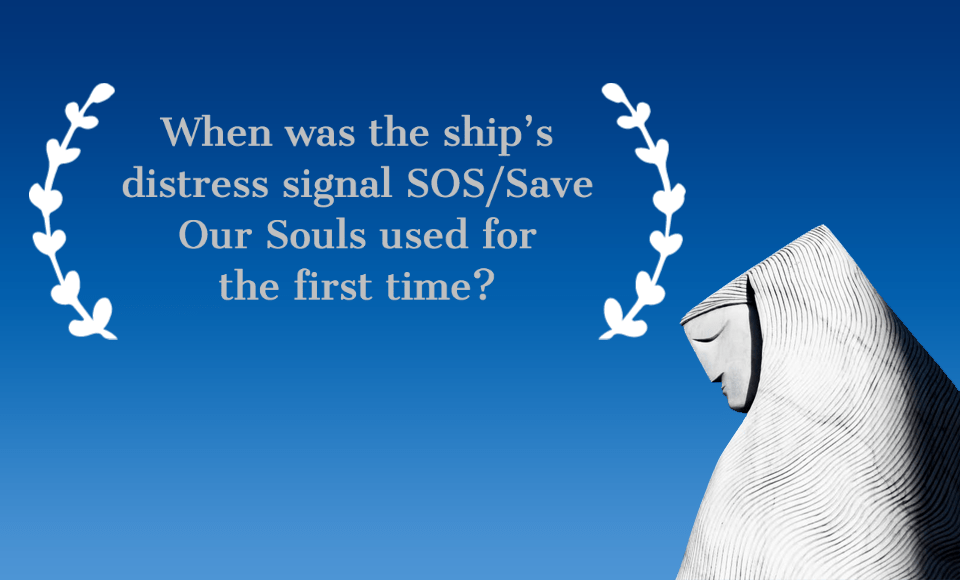A cruise ship with almost 4000 people, including guests and crews aboard, sounds its sirens as the water start to take in from gigantic devouring waves because of a typhoon. The ship signals SOS! To mean “Save Our Ship” or “Save Our Souls” would be the most famous line of rescue that would first come in our head, especially on these emergencies. But SOS means neither of those lines. Yes, we have a wrong understanding of it for a long time.
Even if a lot of people considered it as an acronym, the letters SOS neither actually stand for anything, and the signal isn’t supposed to be three individual letters. Although its appearances are best-known in desert island cartoons, maritime movies, and earworms by ABBA and Rihanna, the letters SOS have been used as a code for an emergency since 1905. But what does the SOS really means?
It all came from a Morse code sequence or a coding system introduced by the German government in 1905. The system used short and long marks, sounds, or flashes of light to represent letters and numbers for sending messages. It is also a set of radio regulations to stand out from less important telegraph transmissions. (click here for more details)
A continuous Morse code string of three dots, three dashes, three dots all run together with no spaces or full stops (…—…) have equivalent letters of S for the three dots and O for the three dashes, thus forming SOS.
The letters made their own visual distress signal divorced from Morse code due to its convenience. In some instances, those who need rescue sometimes spell them out on the ground to be seen from above.
First “S.O.S.”
In 1909, August 11, the wireless operators on the Clyde Line steamer S.S. Arapahoe sent the signal when the ship was disabled by a broken propeller off the coast of Cape Hatteras, North Carolina. It was the first recorded use of S.O.S. as a distress signal. (click here for more details)
The New York Times publication in February 1910 with a front-page article entitled “S.O.S. – The Ambulance Call of the Sea.” reported several incidents that showed how the newly developed wireless technology had become a game-changer for mariners.
However, not everyone aboard adopted the new standard quickly. For instance, the Marconi Company was mainly reluctant to give up on “CQD.” When the Titanic tragedy happened, the operators on board initially just sent that signal after the ship struck an iceberg until the other operator suggested trying the new “SOS” signal.
Why SOS
It is commonly known that “SOS” is an acronym for the phrase “Save Our Ship” that is why it is often written as “S.O.S. However, it is incorrect to put full stops between each letter since in the first place it is not an acronym. (click here for more details)
The sequence of triplet dots and dashes became the international favorite for its simplicity. When transmitted without pause and repeated every few seconds, the meaning of SOS was clear, because it didn’t form any known word or abbreviation. Besides, being sent together as one string (with no stops), it could be sent very quickly and needs very little power to transmit.
There was also a visual appeal, as SOS has instantly-recognizable symmetry. It is a palindrome (a word that reads the same backward and forwards, like civic, deified); it’s also an ambigram, a word with the same looks, whether it is read upside-down or right-side-up. So when it’s written on the boulders on a beach, or carved into a snowbank, SOS will always look SOS no matter which way the rescue plane or chopper approaches.
So, despite various explanations, as the 1918 Marconi Yearbook of Wireless Telegraphy and Telephony notes, “This signal [SOS] was adopted simply because of its easy radiation and its unmistakable character and nothing particular significance in the letters themselves…”
Fast Facts:
- T.D. Haubner was the first person to use the SOS distress signal call from SS Arapahoe in 1909. The ship where he worked on had lost its crew near the Diamond Shoals, which are also known as the “Graveyard of the Atlantic.” A few months later, Haubner, was still working on the SS Arapahoe and had received the world’s second SOS call, but this time, it was sent from the SS Iroquois.
- At the 1906 Berlin Radiotelegraphic Conference, the SOS signal was created and adopted as the universal international distress.
